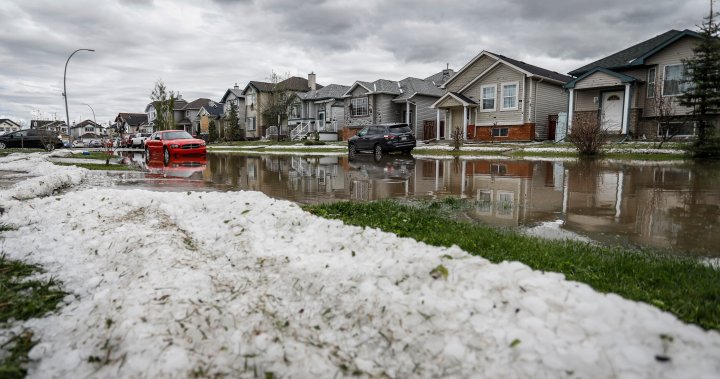Home insurance has become more expensive in Canada this year amid soaring replacement costs and extreme weather events, according to a new analysis.
But experts say there are ways for homeowners to keep their insurance expenses in check.
In January, there was a 7.66 per cent increase in the national home insurance price compared with the same time last year, according to a report published Tuesday by My Choice Financial, a Canadian insurance aggregator and comparison website.
As long as claims continue to increase, the insurance industry will respond by raising rates to pay off those claims, said Daniel Ivans, an insurance expert at Ratesdotca.
“There’s increasing financial pressure that it could put obviously on first-time homebuyers or even anybody that’s on a budget where you’re seeing these substantial increases in insurance,” he told Global News in an interview.
“It could be a bit of a challenge.”
This comes as the Bank of Canada continued to hold its key interest at 5.0 per cent in its latest decision Wednesday.
The high lending rate is already weighing heavy on homeowners, especially those with variable mortgage plans.
While overall inflation has eased in Canada, reaching 2.9 per cent in January, the surging costs for home repairs and replacements have hiked the insurance premiums, the My Choice report said.

Climate-related disasters and higher insured damages are also major contributing factors.
“Home insurance prices depend on the proximity to areas where natural disasters happen most often,” Vitalii Starov, vice-president of growth at My Choice, told Global News.
“While it’s not as relevant for Canada as it is for the U.S., it’s becoming a more important factor with climate change.”
After a warmer-than-usual winter, experts warn that Canadians should brace for extreme weather events, including drought, wildfires and floods in the spring and summer.
Canada exceeded $3 billion in insured damage from natural catastrophes and severe weather events in 2023 – which was the country’s fourth-worst year for insured losses, according to the Insurance Bureau of Canada.
Financial news and insights
delivered to your email every Saturday.
“We’ve got two years in a row now where, as a country, Canada has seen over $3 billion in losses as a result of claims related to weather phenomena,” Ivans said.
Canada experienced a record-breaking wildfire season last year, with roughly 18.5 million hectares of land burned.
If that continues and more losses are incurred this year, that could mean higher home insurance rates, Ivans said.

Where is home insurance rising?
While every province has seen home insurance inflation this year, the increase varies by location.
Saskatchewan saw the biggest jump in January, with home insurance going up 12.16 per cent year over year.
Manitoba was not far behind with an 11.31 per cent increase, followed by Alberta, which saw its home insurance rate spike by 9.25 per cent.
Homeowners in Newfoundland and Labrador saw an 8.53 per cent rise in their home insurance costs, while Nova Scotia had an 8.27 jump in January.
Quebec’s home insurance inflation was 8.02 per cent. For British Columbia it was 7.63 per cent and Ontario saw a 6.32 per cent increase.
New Brunswick at 2.39 per cent and Prince Edward Island at 0.88 per cent had the smallest increments among the provinces.

How to lower your home insurance bill
In Canada, it’s not legally required to buy home insurance if you already fully own a home, but you will most certainly need it when applying for a mortgage through a lender.
Experts also highly recommend it, especially if you live in a high-risk area that could be impacted by severe weather.
“The last thing you want to do is be in a situation where you have to pay for replacement of your home out of pocket, or for the replacement of some damaged items in your home out of pocket,” Starov said. “So it does give you that peace of mind.”
Home insurance can help cover a range of losses or damages from theft, vandalism, fire, wildfires, storms, hurricanes and even legal liability.
“There’s a lot more to home insurance than just covering the home itself,” Ivans said.
“It’s about protecting the contents within your home. It’s about ensuring that if anything does happen to your home, where you need to be relocated for several months while it’s rebuilt, you’re not homeless. You’ve got a place to live.”

While insurance rates set by providers are usually fixed, it is advised to always shop around, ask for quotes and compare prices before deciding on an insurance company.
To save some money, Starov said homeowners can increase their deductibles.
Some insurance companies also give a discount if customers bundle up their home insurance and auto insurance policies.
Premium costs can be reduced by installing alarms and doing renovations on your home, Starov said.
“The replacement cost is something you actually can control, so renovating your old home systems, like wiring and plumbing, will definitely help to reduce the price.”
— with files from Global News’ Uday Rana and Aaron D’Andrea
© 2024 Global News, a division of Corus Entertainment Inc.





